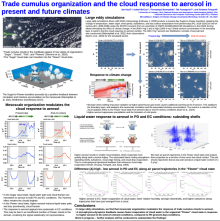Trade cumulus organization and the response to aerosol in present and future climates
Jan
Kazil
University of Colorado and NOAA
Poster
Mesoscale organization of clouds is currently not represented by climate models. Its role for micro- and macrophysical properties of clouds in a changing climate is therefore very likely not captured in climate simulations. Large eddy simulations, the tool of choice for the study of clouds at high resolution, can provide physical insight and guidance for the improvement of climate models.
In the trade cumulus regime, clouds aggregate moisture on the mesoscale, which in turn brings about mesoscale cloud organization. Moisture aggregation is driven by gross moist instability even without precipitation, but latent heating associated with enhanced (diminished) precipitation increases (reduces) gross moist instability. This may render trade cumulus moisture aggregation and cloud organization on the mesoscale susceptible to aerosol.
Furthermore, climate warming sharpens the contrast in humidity between the boundary layer and the free troposphere; between moist updrafts originating from the surface and dry downdrafts originating from the inversion; and between cloudy and cloud-free air. This may result in faster evaporation of cloud droplets and change the response of clouds to aerosol in a future climate.
We analyze the response to aerosol in present-day and late 21st century conditions of trade cumulus clouds in the Caribbean that organize into the ""Flower"" cloud state. Multi-day large-eddy simulations on a 200 km domain (dx = dy = 100 m, dz = 50 m, dt = 2 s) are used. The role of mesoscale dynamics and cloud microphysics is characterized for the cloud response to aerosol, and the susceptibility of cloud properties to aerosol in the considered case in present-day and late 21st century conditions is quantified.
In the trade cumulus regime, clouds aggregate moisture on the mesoscale, which in turn brings about mesoscale cloud organization. Moisture aggregation is driven by gross moist instability even without precipitation, but latent heating associated with enhanced (diminished) precipitation increases (reduces) gross moist instability. This may render trade cumulus moisture aggregation and cloud organization on the mesoscale susceptible to aerosol.
Furthermore, climate warming sharpens the contrast in humidity between the boundary layer and the free troposphere; between moist updrafts originating from the surface and dry downdrafts originating from the inversion; and between cloudy and cloud-free air. This may result in faster evaporation of cloud droplets and change the response of clouds to aerosol in a future climate.
We analyze the response to aerosol in present-day and late 21st century conditions of trade cumulus clouds in the Caribbean that organize into the ""Flower"" cloud state. Multi-day large-eddy simulations on a 200 km domain (dx = dy = 100 m, dz = 50 m, dt = 2 s) are used. The role of mesoscale dynamics and cloud microphysics is characterized for the cloud response to aerosol, and the susceptibility of cloud properties to aerosol in the considered case in present-day and late 21st century conditions is quantified.

Kazil-Jan-poster.pdf
(10.25 MB)
Meeting homepage
